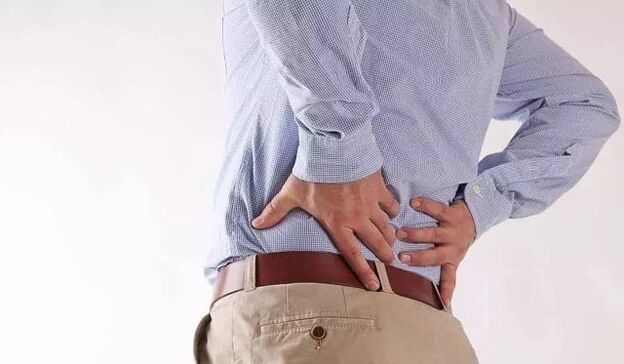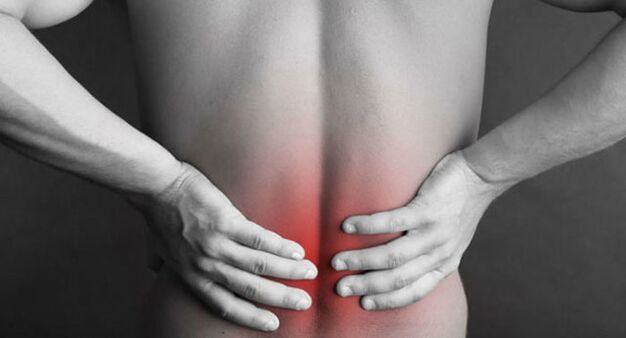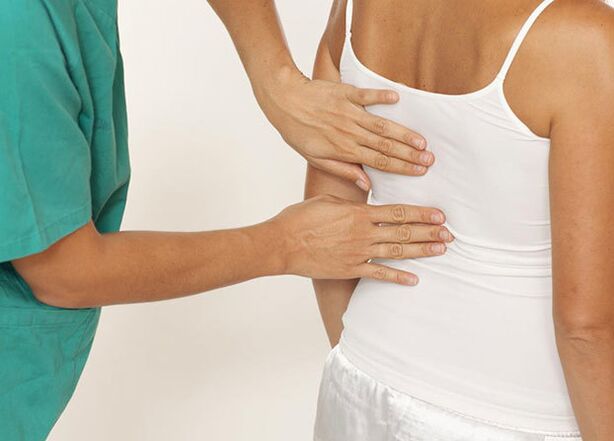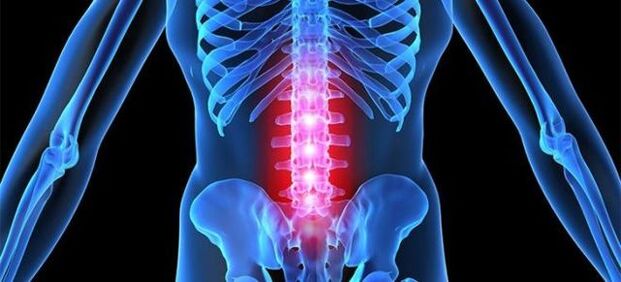About 80% of people over the age of 55 of experience manifestations of various back diseases should not neglect the faces of the younger age categories. Therefore, one of the most common diseases of the vertebral-osteochondous column of the lumbar column was also found in patients of 25-45 years. Even young people aged between 16 and 25 are increasingly suffering from symptoms and causes of this extremely unpleasant disorder. Does the question become logical on the fact that it is possible to stop the trend of the number of patients in general and what to do to each person for preventive purposes so as not to become the victim of this pathology?

Symptoms
With insufficient attention to this disease, a premature diagnosis, its treatment is difficult as secondary diseases or complications occur. As a natural continuation of the pathology, osteochondrosis begins to progress. Its treatment is not always effective and when it will exacerbate or an erroneously prescribed therapeutic course, a risk of disability occurs. Another characteristic problem is the aspect of intervertebral hernias, which is accompanied by unbearable painful sensations. Every day, the possibilities of irrevocable get rid of the Arnia are becoming less and less.
The characteristic clinical symptoms help to recognize the disease in the early stages and avoid these sad consequences:
- Acute pain after night sleep;
- Pain with strong body strong or breeding heavy things;
- The body becomes inactive;
- Signs of scoliosis appear;
- The dream becomes restless;
- The depressive moods arise;
- There are frequent urination.
An independent evaluation of these symptoms cannot be correct, since most of them have a common similarity with the signs of other diseases in the spine or in the joints. Therefore, only a rheumatologist or orthopedist has a competence to talk about the presence of the development of osteochondosis of the lumbar region.
Classification
Differential diagnosis to correctly determine the disease, distinguish it from identical pathologies and determine the course of the treatment, the classification of the phases of this disorder helps:
- PHASE 1 - At this moment, the cartilage structure is just starting to change. But now, pathological processes are influenced by the roots of the nerve finals. As a result of this, the pain is given in the legs. At the same time, the blood flow worsens and inflammation are born. The pains are acute or stupid and appear mainly only after reinforced loads on the axis of the back;
- The second phase begins with the destruction of the fibrous ring in the spine, while the cartilage is thinner and the vertebrae is reduced to the distance between them. The pain in the second stage is acute and acute, sometimes unreasonable. During this period, the mobility of the spine through its axis intensifies, pinch of nerves occur, the pressure on the soft tissues of the muscle corset is created;
- Phase 3 is characterized by a strong compression of muscle fibers and nerve roots. Unbearable spasms and pain with a burning character occur. In the area of defeat, he feels numb. With the intensive development of the disease, signs of paresis and paralysis appear;
- Phase 4 - The growth period of already formed osteophytes (neoplasms with the bone structure). In this phase, changes in degenerative nature are activated, arthrosis appear in the spine and joints. The back becomes inactive and in the absence of the correct treatment - completely immobile.
Diagnostic methods
Since even the ideal knowledge of the clinic and the classification of the osteocondrosis of the lumbar column does not give a complete idea of the pathological processes he caused, a doctor who is engaged in the treatment of pathological processes in the vertebra column
- X -Rings in the front and lateral projection - allows to identify the distortion of the axis, the formation of osteophytes, anatomical anomalies of the vertebrae;
- Magnetic resonance imaging determines the state of the entire area of the damage to the back, it notes fragments of destroyed vertebrae, cartilage and outbreaks of inflammation;
- The computerized tomography gives an idea of the condition of the soft tissues, the bones of the vertebrae, the external shell of the intervertebral disc, in principle, which is in principle for its integrity. and blood circulation in the localization area of the disease.

At the same time, the patient tests for a rheumatoid test, general blood indicators, content of biochemical components. The total results of the survey allow to accurately establish the diagnosis and identify the development phase of the osteochondosis of the lumbar region.
Symptoms and treatment of osteochondosis of the lumbar column
Among the common causes of pain in the back of the rear, the osteochondrosis of the lumbar column, the symptoms, whose treatment has their characteristics characteristics. The disease is the initial stage of the osteocondrosis associated with the process of destruction of the cartilage ring, intervertebral discs, a change in their height towards the reduction, the formation of swelling and pinches of nerve roots. Young people and the elderly can face the disease, regardless of gender, social status and religion. A long absence of the manifestation of the symptoms of the disease leads to the loss of precious time and the transition from a phase of the disease to more serious forms of its development. The main distinctive feature of the osteochondrosis is the border area of the dystrophic changes in the tissues of the vertebrae, which does not go beyond the joint cartilage.
Causes of the initial stadium of osteochondosis
Numerous external and internal factors determine the development of the pathological state of the lumbar region of the axial skeleton. Lumbar osteochondrosis appears due to certain risk factors. These include:
- body aging after 50 years;
- improper posture and anomaly of the anatomical structure of the axial skeleton, which determines the irregular load on the vertebrae;
- Lift weights with a weak muscle frame;
- Hypothermia of the patient's body as a whole and the lower back of the back separately;
- dysfunction of metabolic processes, work of endocrine organs, cardiovascular system;
- Irregular loads on the spine during the performance of production duties, household chores, professional and amateur sports;
- pathologies of the musculoskeletal system of an innate or acquired nature;
- Hypodynamia, high frequency of stressful situations;
- Excess of the patient's body weight;
- Lack of vitamins, minerals, trace elements in the body of a sick person, who are responsible for the health of the spine;
- acquisition of high wheels, uncomfortable platforms;
- The use of high cushions and soft mattresses during rest and sleep.
The frequency of diagnosis of osteochondrosis of the lumbar skeleton is determined by the number of risk factors for its development present in the patient's life.
Diagnosis of the disease
The determination of the degenerative dyeing lesion of one of the five vertebrae of the lumbar space of the axial skeleton provides for diagnostic measures. I am prescribed by a doctor. The consultation with a specialist who knows how to treat lumbar osteochondrosis is collected a history of the disease, the time and characteristics of the manifestation of the signs, the intensity and place of location of painful sensations are clarified. The condition of the muscle fibers in the damage area is determined by the visual examination. The use of the palpation method offers a doctor the opportunity to see an image of the symmetry of the vertebrae and distance from each other. The final diagnosis is established after obtaining the results of further studies. These include:

- X -Raggi, performed in two projections and providing the opportunity to see the position of the vertebrae, the height of the discs, the seal of the plates and the marginal bone outcrops;
- Magnetic resonance imaging, which is a special research method to determine the state of the vascular system and fibrous rings in the degenerative dyeing lesion area.
The objectives and methods of treatment of pathology
The results of the diagnostic measures are the basis for the treatment regime for osteochondosis of the lumbar lumbar skeleton, which pursues some objectives. These include:
- a decrease in the intensity of the pain caused by degenerative stretching lesions of one or more vertebrae of the lumbar skeleton;
- normalization of metabolic processes in cartilage, their restoration and the exclusion of the risk of further destruction;
- reduction of the load on nerve fibers;
- increased blood flow in the fabrics of the spine using massage, physiotherapy procedures;
- Strengthen the muscle frame of the axial skeleton through regular operating therapy exercises recommended by the instructor.
The therapy of fondosis of the lumbar column, whose symptoms and the treatment have its characteristics, consists in the intake and use of pharmaceutical products, traditional medicine recipes, unconventional treatment methods, including italdotherapy. An effective addition in solving the problem of pathology is physiotherapy, water, massage, gymnastics and sports procedures, including special exercises exercises. Popy therapy includes the use of non -steridoid drugs anti -inflammatory, muscle relaxants, condroductors, vitamin complexes with trace elements and minerals.
With very serious pains, blocks of novocaine or lidocaine are prescribed, performed by introducing injections in the places affected by the vertebrae. For local use, ointments, gels, creams, ratings with a heating and anti -inflammatory effect are prescribed. The physiotherapy treatment includes the passage of healing courses of the electrophoresis, diakinnamic currents, exposure to ultraviolent, manual procedures, impact wave and reflexology. In the absence of positive dynamics, the aspect of herniaic protrusions, a surgical operation, is prescribed. In order to avoid the development of complications with the appearance of the first symptoms, the treatment must start immediately.
Lumbar osteochondrosis
Lumbar osteochondrosis is one of the most common forms of the underlying disease, in reality osteochondrosis. The lumbar osteochondrosis, whose symptoms are equally determined by men and women, manifested in the form of pain concentrated in the sacred area, reflected in their symptoms and at the inferior ends, which is often determined by patients as "pinching of the lumbar nerve".
Protrusion for lumbar osteochondosis
Protect in this area of interest for us develop more often, moreover, they are protrusions that cause the appearance of pain in the lower back. The lumbar region itself, given its position and characteristics, is more subject to the emergence of some functional problems. That is, when considering this statement on the one hand, it can be distinguished that our center of gravity refers directly to the lumbar department, respectively, it is precisely on it that a significant part of the load accounts. When considering, on the other hand, it can be seen that a significant size of the movements, again, falls on this lumbar region. Having said that, the greatest tendency to damage (as well as the protrusions of interest for us) is on the discs concentrated in the lumbar region. Furthermore, we must not forget that the changes in the records in this and, of course, in other areas, they also occur on the background of the degenerative processes related to age.
Remember our readers what the protrusions are themselves. The connection of the discs between them in the spine is provided by the wheels according to the cartilage. The main components of the intervertebral disc are a core of pier and a fibrous ring, through which the fixation is provided inside the framework of the spinal disc. The impact of some factors and conditions causes the possibility of breaking this ring, on which the protrusion of the nucleus occurs in turn. As a result of this process, hernia develops. As for the protrusion, it is already developing following a similar course of the process, but without the concomitant breakage of the ring - in this case it is simply subject to thinning and not a break, because the core protrudes directly through the ring. In reality, this protrusion is defined as protrusion.
As for the symptoms of the protrusion, it is manifested as follows:
- a feeling of rigidity in the lower back;
- pain in the lumbar region;
- Lower pain of chronic nature;
- lumbosacral root;
- numbness, pain, tingling fingers on the legs, on the feet;
- compromised urination functions (in rare cases of pathology in question).

Mainly, conservative treatment is applied to the protrusion of the lumbar disc. In the meantime, significant in the development of the protrusion is often accompanied by serious symptoms, resistant to treatment, in this case, it is no longer possible to do without surgery.
Treatment
Mainly the treatment of osteochondrosis is multicomponent and quite complicated in its implementation. Mainly all therapy measures are reduced to the following points:
- pharmacological treatment;
- if necessary - surgical treatment;
- diet;
- Medical physical education.
The exacerbation of the disease requires, first of all, respect for bed rest for patients. The main recommendation for this part is a place of hard/hard sleep. Extremely expressed in the events, the attacks provide for the need for a minimum load and in early contact to the relevant specialist.























